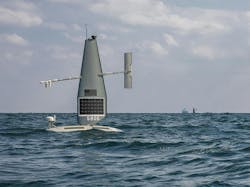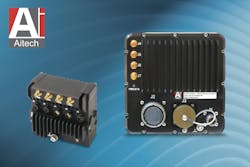Today's warfighters and those who command them have more intelligence at their fingertips than the combined generations that preceded them. Actionable intelligence comes from an exponentially larger amount of information, and all of this data stems from a torrent of sensors.
Sensor and signal processing, driven by cutting-edge technological advancements, has become the linchpin of military systems, reshaping the way armed forces perceive, analyze, and respond to threats.
In military systems, signal processing is crucial for various applications, including radar for target detection and tracking, communications for secure information exchange, electronic warfare (EW) for signal jamming and deception, and intelligence gathering through signals intelligence (SIGINT). The ability to process and interpret signals accurately is vital for the success and efficiency of modern military operations.
Thanks to advancements in processing technology, even more of the information is turned into intelligence closer to the sensor resulting in the ability to seize an advantage more quickly than in the past.
Emil Kheyfets, director of engineering at Aitech Systems in Chatsworth, Calif., says that the biggest trend the company is seeing in sensor and signal processing is the movement of processing tasks to artificial intelligence at-the-edge (AIAE) systems.
"Modern sensors produce large amounts of data, so from a technology perspective, the growth area is to improve data processing and reaction time speed, Kheyfets says. "To do this, the data needs to be processed as close to the sensors as possible. In the mil-aero environment, reaction time is a critical factor for lives saving decisions."
AI-enabled
Artificial intelligence (AI) plays a significant role in enhancing military signal processing capabilities. The integration of AI into military systems brings about improvements in speed, accuracy, and adaptability, enabling more effective and efficient processing of signals.
AI algorithms can be trained to automatically recognize and classify different types of signals. This includes identifying specific communication protocols, radar signatures, or EW signals. Machine learning models, such as neural networks, can learn patterns and features from large datasets, allowing for rapid and accurate signal identification.
"Besides AIAE capabilities, high-performance AI-enabled embedded computing systems are capable of fully autonomous operation with minimal or with no interaction with command centers," Aitech's Kheyfets says. "The increased robustness of advancing AI algorithms enables their use in safety-critical applications throughout uncrewed and autonomous systems. It also helps missions continue when faced with jammed communications."
As AI and machine learning are effective at recognizing patterns in a mountain of data, it is also useful in finding anomalies in the same information. This capability is valuable for identifying potential threats or irregularities in the electromagnetic spectrum. Anomalous signal detection can help in early warning systems, where deviations from normal patterns could indicate the presence of adversarial activities or EW.
AI algorithms can help reduce false alarms by distinguishing between genuine threats and harmless signals or noise. By continuously learning and refining their models, AI systems become more adept at filtering out non-critical information and focusing on signals of strategic importance.
Kevin So, director of product marketing for the Microchip Technology communications business unit in Chandler, Ariz., says that processing power is key to enabling autonomous operations.
"Autonomous systems need to have the smarts to quickly process the necessary data to make real-time decisions, like vision systems in autonomous aircraft or spacecraft. This requires a certain level of AI/machine learning capabilities. More and more embedded processors will need to support various degrees of hardware accelerated vector processing to support the unique workloads in autonomous systems."
Aitech's Kheyfets concurs, saying "High-performance AI-enabled embedded computing systems, high-definition sensors, and related software enable AIAE capabilities, which allow for high precision and high-speed data processing that enhance decision-making abilities. Making the right decisions faster than adversaries helps mission readiness and mission success on the battlefield."
In radar and sensor systems, AI can track multiple targets simultaneously, and predict their future movements. This capability is crucial for air defense, missile systems, and surveillance applications.
AI algorithms enable adaptive digital signal processing, where systems can adjust their parameters dynamically based on changing conditions. This is important in EW scenarios, where adversaries may employ tactics to evade detection. AI allows military systems to learn and adapt to new signal characteristics and tactics, enhancing overall resilience.
Open standards
While today's embedded computing systems must process an incredible amount of information, such systems also must adhere to the U.S. Department of Defense (DOD) requirement for manufacturer-agnostic components and open system standards to enable interoperability in design.
One such avenue in this arena is seen in The Open Group's Sensor Open System Architecture (SOSA) initiative. With SOSA, innovation and the insertion of new technologies become more straightforward. As new sensor technologies emerge, they can be integrated into existing systems without disrupting the entire architecture. This facilitates the continuous improvement of military capabilities over time, and in the case of signals processing, intelligence is provided closer to the edge.
SOSA also supports scalability, allowing systems to be easily scaled up or down based on mission requirements. Whether it's adding new sensors, expanding the capabilities of existing ones, or integrating with other systems, SOSA provides a scalable framework that accommodates evolving needs.
Standardization through SOSA simplifies maintenance and logistics. With a common set of interfaces and protocols, it becomes easier to manage and support sensor systems in the field. This is crucial for ensuring the reliability and availability of systems in mission-critical situations.
Microchip's So says open systems requirements are taking off -- literally -- for non-terrestrial tech.
"While there are space-specific system standards, they often face interoperability challenges," says So. "However, as the space market continues to expand, driven by both commercial/private applications and as well as the new space race, we see SOSA as a natural model for this segment.
He continues, "Specifically, we are seeing strong interests in standardized, interoperable, and radiation-hardened embedded processing single board computers (SBCs) for space applications in systems for both defense and non-defense. Besides interoperable SBCs, we are seeing the need for systems to support SSD [solid state drive] based NVMe drives to support real-time, localized, data and imaging processing in conjunction with FPGA-based hardware accelerators cards – all of which are interconnected with standardized open networking protocols like Ethernet and PCI Express (PCIe)."
Microchip's So explains that his company views the adoption of open and standardized technologies in networking as a key focus.
"Specifically, we see Time Sensitive Networking (TSN) being strongly evaluated and embraced by various [aerospace and defense] agencies, in everything from ground-based vehicles to fixed-wing aircraft and spacecraft.
He continues, "Today’s modern ground and aerospace platforms require high-bandwidth and deterministic networking. Historically, with bandwidth not being a challenge, this requirement was met with legacy control bus protocols like MIL-STD-1553 or proprietary/single-vendor/expensive technologies like Time-Triggered Ethernet (TTE). However, these technologies are no longer sufficient in today’s high-bandwidth environments. This is where TSN comes in. TSN is an industry-standard, multi-vendor-based protocol that delivers deterministic and fault-tolerant networking with the bandwidth scalability of standard Ethernet. TSN is proven and used in a variety of non-[aerospace and defense]applications already today, from industrial automation to automotive networking. Most recently, IEEE has enhanced TSN with an aerospace-specific profile called 'P802.1DP – TSN for Aerospace Onboard Ethernet Communications.' These enhancements address the unique needs of [aerospace and defense] applications."
Staying open
So also notes that Microchip anticipates that the RISC-V ISA standard will be increasingly leveraged in the military and aerospace sector.
"No longer just an emerging interest, but a growing requirement is to leverage the RISC-V ISA for embedded processing," So says. "RISC-V is especially suitable for supporting the needs of workloads requiring power efficient vector instruction set processing in image and vision processing applications.
RISC-V is an open-source instruction set architecture (ISA) based on reduced instruction set computing (RISC) principles. It is designed to be simple, modular, and extensible, providing a foundation for building various processor implementations. RISC-V is unique in that it is open-source and freely available, allowing anyone to design, implement, and distribute processors based on the RISC-V ISA without licensing fees.
Like SOSA, the RISC-V ISA is designed to be scalable from small, embedded devices to large, high-performance computing systems. This scalability makes it suitable for a wide range of applications, from microcontrollers to data center servers.
According to RISC-V International, the nonprofit organization shepherding the instruction set, there are now nearly 4,000 RISC-V members across 70 countries, including processing giants like Qualcomm, Intel, and AMD.
"RISC-V combines a modular technical approach with an open, royalty-free ISA — meaning that anyone, anywhere can benefit from the IP contributed and produced by RISC-V," the organization says. "As a non-profit, RISC-V maintains no commercial interest in products or services. As an open standard, anyone may leverage RISC-V as a building block in their open or proprietary solutions and services."
Microchip's So says that "As an open standard, RISC-V allows companies and agencies to innovate cost effectively. With the recent formation of RISC-V Software Ecosystem (RISE) by the Linux Foundation, the software ecosystem for RISC-V will further be accelerated to ensure broad market adoption."
Making space
Operating in the vacuum of space makes signal and sensor processing technologies a bit more difficult than their Earthbound cousins. In the latter half of 2022, officials of the U.S. National Aeronautics and Space Administration (NASA) announced the agency's Jet Propulsion Laboratory had tapped Microchip Technology to develop the agency's High-Performance Spaceflight Computing (HPSC) processor that will provide at least 100 times the computational capacity of current spaceflight computers.
"This cutting-edge spaceflight processor will have a tremendous impact on our future space missions and even technologies here on Earth,” Niki Werkheiser, director of technology maturation within the Space Technology Mission Directorate at NASA headquarters in Washington said when the contract was announced. "This effort will amplify existing spacecraft capabilities and enable new ones and could ultimately be used by virtually every future space mission, all benefiting from more capable flight computing."
Over three years, Microchip aims to architect, design, and deliver the HPSC processor, intending to use it in upcoming lunar and planetary exploration missions. Microchip's processor architecture is anticipated to enhance overall computing efficiency for these missions by allowing scalability of computing power based on mission requirements.
The design will prioritize reliability and boast increased fault tolerance. The processor is expected to empower spacecraft computers to perform calculations at speeds as fast as 100 times quicker than current state-of-the-art space computers. This initiative is part of NASA's ongoing commercial partnership endeavors and will be executed through a $50 million firm-fixed-price contract, with Microchip making substantial contributions toward research and development costs to successfully conclude the project.
Existing computing technology designed for space missions tends to focus on addressing the most computationally demanding aspects of a mission, resulting in overdesign and inefficient utilization of computing power. Take a Mars surface mission, for instance, where high-speed data movement and intensive calculations are crucial during the planetary landing sequence.
However, routine mobility and science operations necessitate fewer calculations and tasks per second. Microchip's innovative processor architecture introduces flexibility, allowing processing power to adapt based on current operational needs. Additionally, specific processing functions can be deactivated when not in use, effectively reducing power consumption. This capability is expected to significantly conserve energy and enhance overall computing efficiency for space missions.
When asked about technologies his company offered that showcased data processing prowess, Aitech's Kheyfets cited their small form factor, rugged AI-capable supercomputers designed for uncrewed and autonomous systems like drones, uncrewed ground vehicles, and robotics.

Jamie Whitney
Jamie Whitney joined the staff of Military & Aerospace Electronics and Intelligent Aerospace. He brings seven years of print newspaper experience to the aerospace and defense electronics industry.
Whitney oversees editorial content for the Intelligent Aerospace Website, as well as produce news and features for Military & Aerospace Electronics, attend industry events, produce Webcasts, oversee print production of Military & Aerospace Electronics, and expand the Intelligent Aerospace and Military & Aerospace Electronics franchises with new and innovative content.




